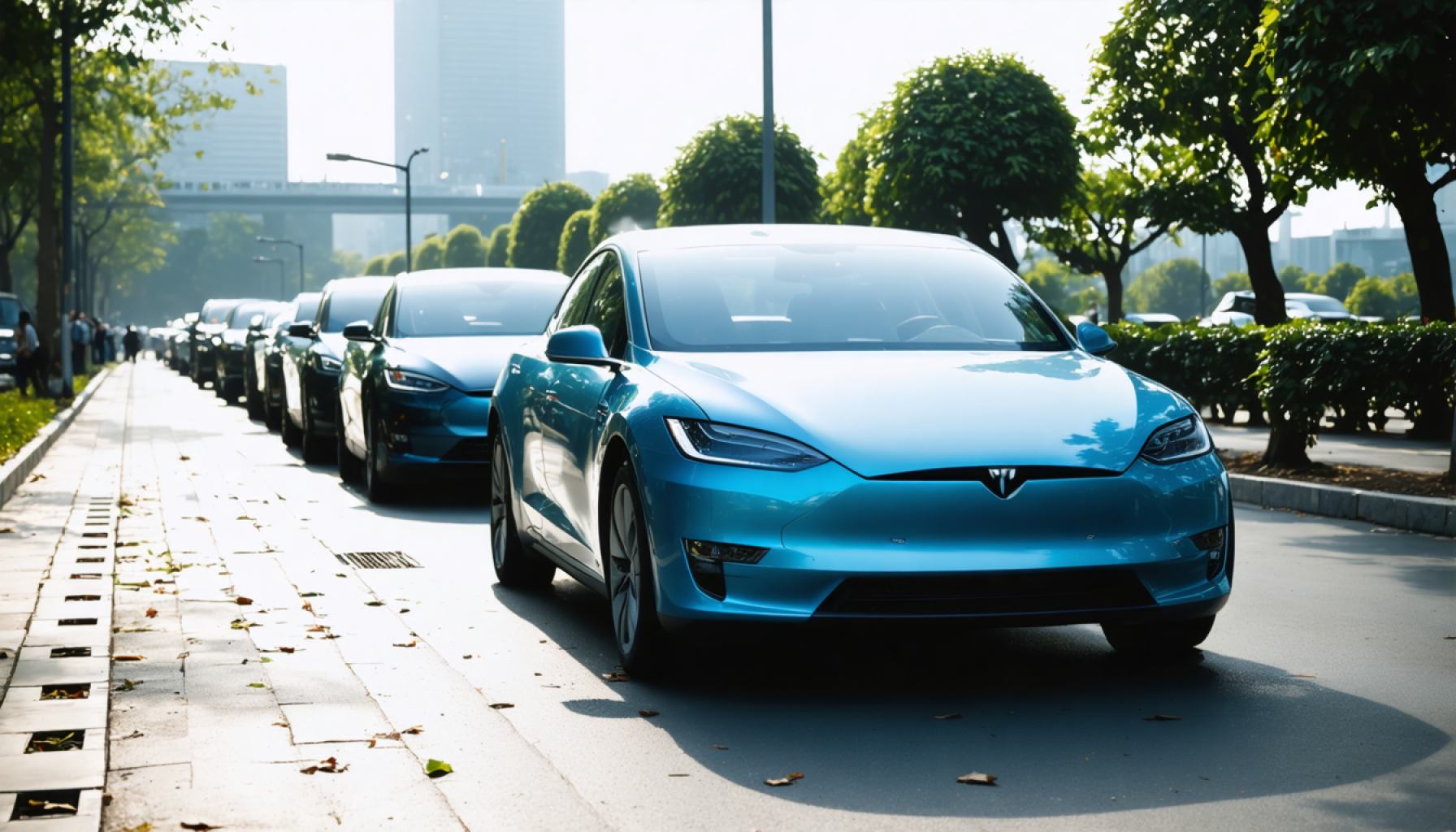- The electric vehicle (EV) market in China is rapidly evolving but shows mixed results for manufacturers.
- Tesla faced an 80% drop in registrations, with only 3,600 vehicles registered, while Nio and BYD also experienced declines of 40% and 25% respectively.
- Xpeng defied the trend with a 21% increase, registering 7,500 vehicles in a week, highlighting its strategic adaptation to consumer needs.
- The figures reveal key insights into market dynamics, amidst tensions between data transparency and industry control in China.
- Despite challenges, Xpeng’s success underscores the importance of agility and strategic maneuvering in a competitive landscape.
The electric vehicle (EV) landscape in China is evolving at a breakneck pace, driving the nation towards a sustainable future, yet recent registration numbers reveal a mixed bag for manufacturers. Storm clouds gathered over the sector for giants like Tesla, who saw a precipitous drop in registrations by a staggering 80% to just 3,600 vehicles. Even domestic powerhouses weren’t immune; Nio tumbled by 40% with only 1,800 registrations, and BYD saw a 25% decline, though they still managed to move 45,100 vehicles. These figures whisper tales of a market twisting and turning through the mists of economic and competitive pressure.
However, amidst this turbulence, Xpeng shines like a beacon with an electrifying 21% increase, registering 7,500 vehicles in just a week. A testament to its nimble navigation of the industry’s currents, Xpeng’s impressive performance comes in stark contrast to its competitors’ struggles. Not merely a flash in the pan, this surge highlights a broader trend in Xpeng’s strategic playbook: keen adaptation to consumer demand coupled with enticing features and competitive pricing that resonate with tech-savvy buyers.
These numbers, withdrawn from weekly reports since the China Association of Automobile Manufacturers (CAAM) urged a halt, nonetheless offer a snapshot many stakeholders crave. While the official stance insists these figures “fuel vicious competition” and disrupt the “industry order,” savvy analysts and consultants see them as vital tools. They help not just in gauging market pulse but also in crafting forecasts that align with monthly deliveries, offering a barometer of consumer preferences and economic sentiment.
The ongoing tension between transparency and control in the Chinese auto market underscores a perennial struggle—information flow versus industry harmony. Yet, amidst the opacity, the shine from Xpeng’s triumphant numbers cuts through the fog, casting a spotlight on agility as a critical asset in today’s volatile market. It suggests that amidst setbacks, seizing opportunities with swift and strategic maneuvers can yield extraordinary results, even when giants falter.
Is Xpeng Poised to Lead China’s EV Revolution? The Untold Story Behind the Numbers
The Evolving Landscape of China’s EV Market
The electric vehicle (EV) market in China is undergoing significant changes, driven by swift innovations and a burgeoning demand for sustainable transport solutions. Although some industry giants like Tesla, Nio, and BYD recently experienced steep drops in vehicle registrations, Xpeng’s rise hints at underlying shifts in consumer preferences and industrial strategies.
Understanding the Registrations Decline
1. Economic Pressures: A downturn in the registration numbers for stalwarts like Tesla and Nio reflects broader economic challenges, including fluctuating consumer confidence and global supply chain constraints.
2. Competitive Landscape: Increased local competition is influencing market dynamics. Companies like Xpeng, with localized strategies and appealing offerings, are beginning to overshadow traditional leaders.
3. Policy and Regulatory Changes: The Chinese government frequently adjusts EV policies, which can unpredictably impact sales and registrations.
Xpeng’s Strategy for Success
1. Innovation and Features: Xpeng’s success can be attributed to its continuous innovation in technology and design. Featuring enhanced autopilot systems, cutting-edge infotainment, and competitive range metrics, Xpeng appeals to tech-focused younger demographics.
2. Pricing Strategy: With competitive pricing, Xpeng is addressing the middle-market segment, offering value-packed options that attract cost-sensitive buyers.
3. Consumer-Centric Approach: By leveraging consumer feedback and adapting quickly to shifting demands, Xpeng maintains a nimble position that allows it to pivot more swiftly than its larger competitors.
Industry Insights and Trends
– EV Demand Growth: The demand for electric vehicles in China is expected to grow as the government pushes for greener initiatives and urban areas switch to cleaner mobility options.
– Technological Advancements: With developments in battery technology and increased charging infrastructure, the industry is poised for transformative growth.
– Policy Influence: Government incentives and regulation will vastly influence the trajectory of EV growth and market share distribution among different players.
Key Questions & Answers
Why is Xpeng gaining ground while others struggle?
Xpeng’s adaptability and focus on consumer demands have provided it with an edge. Its innovative features and value-focused pricing resonate well with the market.
What are the risks of investing in China’s EV market?
Investors should consider regulatory risks, market saturation, and technological obsolescence, which could impact the market and specific company’s performances.
Recommendations for EV Stakeholders
1. Adapt Quickly: Emulate Xpeng’s approach by staying agile and responsive to consumer demands and market changes.
2. Focus on Innovation: Invest in technological advancements, including battery efficiency and autonomous driving features, to stay ahead.
3. Consumer Engagement: Enhance customer relations and feedback mechanisms to align product offerings with market needs.
4. Monitor Policy Changes: Keep a keen eye on regulatory changes and government incentives that can significantly impact the market landscape.
For more insights into the evolving landscape of China’s electric vehicle market and the mysterious rise and fall of different automakers, you can check Xpeng and other manufacturers like Tesla. These resources provide comprehensive details about their strategies, products, and current news.
Conclusion
The prowess of Xpeng amidst declining registration figures of its competitors serves as a compelling narrative of strategic foresight and market alignment. Stakeholders in the EV market should draw lessons from Xpeng’s success, focusing on innovation, consumer connection, and rapid adaptation to maintain competitiveness in this fast-evolving industry.
